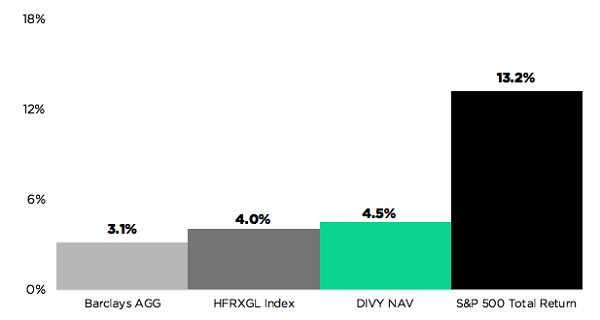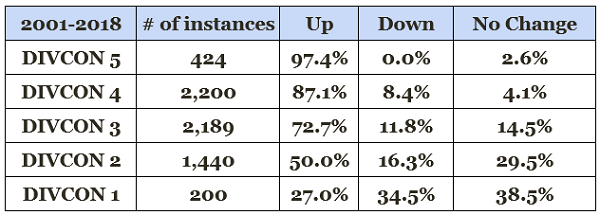Eric Ervin was making his wealthy client so much money that he suggested: “Hey, why don’t you just quit your job?”
The investor saw the opportunity to scale Eric’s “secret strategy” – and he wanted to help fund a new venture to bring this brilliance to the financial masses!
Both guys knew the power of dividend growth investing. But Eric’s second-level insight is what made them both a boatload of cash. He figured out a way to bet purely on the higher payouts – as close to a “sure thing” as you’ll ever see in stocks. Here’s what I mean.
Blue chip stocks tend to raise their dividends every year. Even if it’s a token increase, it keeps shareholders happy. S&P 500 dividend growth is the reason that index investing “works.” Its collective payouts are almost always rising and they pull 500 share prices along with them:
This Orange Dividend Line Powers 500 Stock Prices

Problem is, traditionally there’s been no way to bet on the orange line above. You’d have to buy the index and hope its price (blue line) appreciates in tandem. That might be OK if you have a multi-decade timeframe, but if you need your money in a few years then manic market plunges (like we saw in December) might derail your retirement hopes.
Well, Eric figured out that he could buy “swaps” on S&P 500 dividend growth itself. This was an innovative way that he and his rich clients could bet on dividend growth only, without being exposed to price fluctuations.
He eventually launched the Reality Shares DIVS ETF (DIVY) in 2014 to bring this strategy to individual investors (and was kind enough to walk through the specifics with me on the phone at the time).
The genius of DIVY is that it capitalizes on the underappreciated annual tradition of dividend raises. For 43 of the last 46 years, S&P 500 companies have increased the total dividend payout. This results in steady gains that track payout growth rather than price action.
DIVY’s “heartburn” levels –price ups and downs that cause digestive difficulty – are closer to that of bond funds. Here’s how its volatility (measured by standard deviation, a statistical measure of price fluctuation) stacks up with two bond funds (left side below) and the price of the S&P 500 itself (right side):
Dividend Growth Itself Causes Less Heartburn

So should we buy DIVY and call it a day? With S&P 500 growth projected to be 8% in 2019, it’s not a bad idea. But Eric has a newer fund that should provide us with even more upside.
One Click for the 61 Best Dividend Growers in 2019
Since launching DIVY, Eric and his team created a five-tier rating system called DIVCON that provides a snapshot of dividend health for individual companies. It combines and weights seven factors (such as cash flow, earnings growth, and shareholder payouts) to provide a comprehensive snapshot of a company’s dividend health.
DIVCON 5 is the best bucket. It means the dividend is in good shape, and there’s a 97.4% likelihood that it’ll be increased in the next year.
DIVCON 1 is the danger zone. It means the dividend is more likely to be cut than increased in the next 12 months.
Over the past 15 years, investors who would have traded off DIVCON ratings – buying the fives, and selling or shorting the ones, would have done quite well:
DIVCON’s Dividend Prescience

By now you probably know that higher payouts drive stock prices up. But we can’t look in the rearview mirror to predict future dividend growth and stock returns. We need a leading indicator – like DIVCON.
And Eric is making outperformance easy for us individual investors. Thirteen months ago he launched the Reality Shares DIVCON Leaders Dividend ETF (LEAD) to buy DIVCON’s top stocks and hold them for a year. Many of them boast dividend charts like these beautiful staircases:
Stairway to Payout Heaven

Everyone loves dividends, but dividend hikes are often underappreciated. Not only do they increase the yield on your initial capital, but they also reflected in a price increase for the stock.
Let’s say a stock pays a 3% current yield and then hikes its payout by 10%. It’s unlikely that its stock price will stagnate for long. Investors will see the new 3.3% yield, and buy more shares. They’ll drive the price up, and the yield back down – eventually towards 3%. This is why your favorite dividend aristocrat never pays a high current yield – its stock price rises too fast!
Heck, Visa (V) has never yielded even 1%! But that hasn’t stopped its stock from appreciating 892% over the last decade, thanks to a dividend that increased an equally amazing 852%:
Life Takes Visa (and its Dividend)

The LEAD ETF is a convenient way to get exposure to stocks that are “at-risk” of becoming the next Visa thanks to rapid share price appreciation. With DIVCON looking ahead, you can use this fund to create a diversified portfolio of the 61 blue chip stocks most likely to raise their dividends over the next 12 months.
My #1 Pick From LEAD’s Screen
As Eric improved on the “dumb” yet effective dividend growth screen, we can further improve on his by cherry picking DIVCON’s best. After all, he has to own 61 names so that his ETF has enough liquidity – but we individual investors can buy only the very best!
Texas Instruments (TXN) is a great example of an underappreciated stock we’ve profited from in my Hidden Yields research service (+16.7% yearly returns while we’ve owned it).
Since 2012, its share price (blue line below) as consistently lagged its payout (orange line below). Try as it might, TXN the stock (+358%) hasn’t been able to catch up with TXN the dividend (+464%):
TXN’s Magnetic Dividend Drives 358% Stock Gains

Since dividends follow their share prices higher, we can make the most money by buying when these payouts are most likely to “snap higher” towards their runaway dividend curves.
In other words, we buy the price dips when the dividend appears to be running away. Anyone who says you can’t time stocks hasn’t used this surefire strategy for buying shares ready to “catch up” to their runaway payouts.
It’s simple:
- Plot a stock price versus its dividend,
- Look for a “lag” between the shares and the payout, and
- Buy any big lags you see.
And thanks to the Q4 pullback in stocks, we have plenty of great snapback candidates. I’ll share my favorite pick with my Hidden Yields subscribers this Friday.
Its next dividend hike is likely to be huge, and will place the stock in serious “snap back” territory. Which means the best time to buy it is today, before Wall Street wakes up. I’ll be emailing my full analysis to my Hidden Yields subscribers this Friday – click here if you’d like to sign up to receive it.
